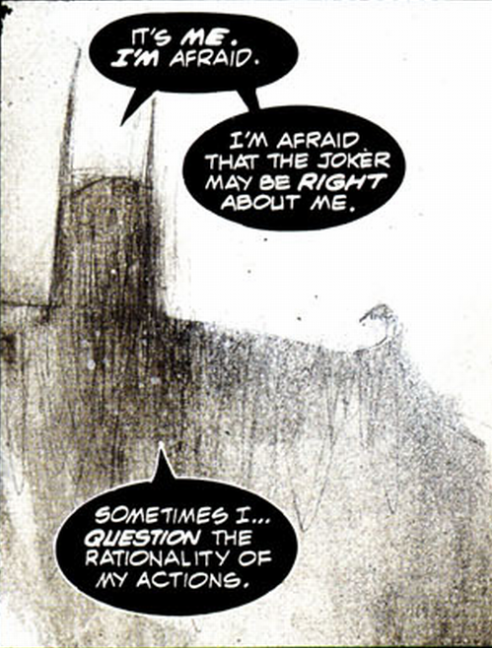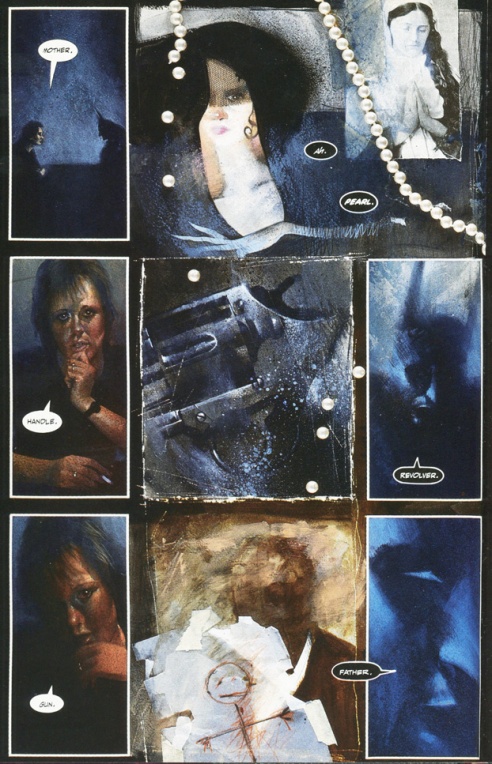Review: “Batman: Arkham Asylum: A Serious House On Serious Earth”
“Sometimes…sometimes I think the Asylum is a head. We’re inside a huge head that dreams us all into being. Perhaps it’s your head, Batman. Arkham is a looking glass. And we are you.” So says the Mad Hatter, in a fit of revelation. “Arkham Asylum: A Serious House on Serious Earth” explores the relationship between Batman and his rogues gallery through the interlocking stories of the asylum’s founder, Dr. Amadeus Arkham, and Batman’s journey through the present-day asylum and his encounters with its inhabitants. Dr. Arkham’s descent through the asylum’s history is told through his journals and are juxtaposed against the descent of Batman through the asylum and the effect he and his villains have on one another. Grant Morrison tells a tale of Batman and his “family” of rogues that is very adult and rife with symbolism and meaning, fleshing out the character of Batman as someone who may be more similar to his antagonists than he wishes to believe. Artist Dave McKean is an equal player in the telling of this tale, terrifying whoever enters this book with images of surrealism, true horror, and an expressiveness that is all his own. This story of symbols and madness is unlike any book because of the imagination and intelligence of Morrison and the unique artistry of McKean. This graphic novel wouldn’t be the same if either one had not been associated with it, with their synergy making it one of the defining, adult, and revelatory graphic novels ever written. It’s also the best-selling graphic novel of all time, making it one for the history books.
The relationship between symbolism and madness is a strong one that is fully explored through Batman’s world and the world of Morrison and McKean’s book. The symbolism of time, expressed by the clock, appears throughout Dr. Arkham’s story, haunting his world. Time is a backdrop to the distress and tragedy that gradually pervades his world. In the background art of many of Arkham’s scenes, the cogs of a clock can be seen, adding a sense of foreboding of his slow descent into madness. The symbolism of time is also prevalent throughout the book because Batman enters the Asylum on April Fool’s Day, which is especially appropriate because the Joker invites (or, more appropriately, forces) Batman into the Asylum on this day. An especially tragic use of the cuckoo clock and it’s innocence is a symbol that is appallingly perverted in one scene, mirroring Bruce Wayne’s rebirth into Batman. The dollhouse becomes an even more potent symbol for Amadeus, mirroring the madhouse that will transform his childhood home into Arkham Asylum. Symbolism, as one can see, is rife within this tale.
Batman as a symbol is fully embraced by Bruce Wayne when Commissioner Gordon says he understands if he’s afraid of entering Arkham Asylum alone among the unleashed inmates. Batman says, “Batman’s not afraid of anything. It’s me. I’m afraid…Sometimes I…question the rationality of my actions. And I’m afraid that when I walk through those Asylum gates…When I walk into Arkham and the doors close behind me…It’ll be just like coming home.” Batman is obviously a symbol to Bruce, one that protects him against his enemies. By realizing that he’s exactly like his foes because of a reliance on the comfort of an alternative identity, he knows he stands on that precipice of sanity and insanity. The fear that Bruce Wayne the man, not Batman the mask, has is rational. He knows that dressing up as a bat is not “normal”, yet that self-awareness makes him stronger than his foes. Or does it? When Batman enters Arkham Asylum, McKean beautifully creates a mirror image of when Amadeus entered the Asylum a few pages before. Amadeus, almost a century before, entered a house that had a tree full of life and greenery overlooking it. When Batman enters, the atmosphere is much darker and the tree is dead and leafless. These two men, one from the past and one in present day Gotham City, become more similar as the story progresses. The connection, toward the end, becomes a haunting and breathtaking one that reveals more of a connection than the reader would have ever imagined.
The Joker and Batman, through Morrison and McKean’s story, is shown to be a relationship of complete opposites. Where Batman thrives on imagery and symbolism, finding meaning in objects and ideas, the Joker is truly an agent of chaos. Dr. Ruth observes that the Joker has “no control” over the “sensory information” he receives from the world and copes with that chaos by “going with the flow.” She observes “that’s why some days he’s a mischievous clown, others a psychopathic killer. He has no real personality. He creates himself each day. He sees himself as the lord of misrule, and the world as a theatre of the absurd.” Batman, though, is in complete control of himself and his surroundings. He controls his world by becoming something that comforts him as well as destroys the evil that caused him so much grief as a child. Batman is a “lord” of rules, order, and the idea that good must always trump evil. McKean’s interpretation of the Joker is one of intense madness, ugliness, and even deformity. His face at times seems distorted into a horrific mass of clay formed into a mask, with his green hair wildly flowing to and fro. The different looks of the Joker just add to the chaotic nature of the character and the horror he inflicts on whoever he chooses to kill, maim, or torture (physically or psychologically).
When the joker sees a rorschach test, he sees many random things and events. Batman, however, takes a look at it and the Joker asks what Batman sees in it. After the reader turns the page, there, in its full majesty and power, is a full page spread by McKean of a huge bat with a glowing light coming from its mouth. The Joker then insists that Dr. Ruth and Batman play a word association game. Batman says he’s not afraid and that, “It’s just words.” McKean and Morrison get into Batman’s head with these associations, with the art in concert with the story. With each word that Dr. Ruth says, an image, or symbol, is uttered by Batman and shown through McKean’s eerily evocative art. The word “mother” conjures up the word “pearl” and an image of a woman and the descent of pearls from a broken pearl necklace goes down the page. Next to the woman is what seems like a photograph of a nun praying. Religious imagery, as evidenced here, is prevalent throughout the book and adds another dimension that can be explored through multiple readings of this book. Then the word “handle” leads Batman to say “revolver.” “Gun” is then associated with “father” and a child’s drawing of a stick figure on paper is shown in front of an image of someone who has no face. “Father” equals “death” and “end” causes him to say “stop.” He says “stop” again, with his head bowed in obvious pain. From the image of the bat to the many images that are conjured by the word association game, Batman is shown to be ruled by symbols and is affected by them greatly. Like his foes, aside from the Joker, symbolism helps him to keep focus, yet also haunts his dreams and waking hours.
Special mention must be lavished upon the art in this book. Dave McKean has an art style unlike any I’ve ever encountered in my twenty five years of reading comic books. As a child of nine, I remember being perplexed by this book, yet also had my mind opened to ideas and imagery of a character that went deeper than I had encountered of any interpretation of Batman (aside from “The Dark Knight Returns”, which I read during the same year). This was definitely not the Batman from the 1960s television series. McKean’s art enhances Morrison’s script, mixing different styles, at times making collages on the page. Pieces of fabric, photography, and other mixed media are used, adding a magical effect that transforms the story into one of even greater depth, horror, and pathos. Gaspar Saladino’s lettering is art in its own right, with his use of different lettering for each character. The Joker’s blood red dialogue seems to be dripping off the page, as if splattered in a fit of anarchy. Batman’s word balloons are pure black and the letters are white, emphasizing a light hidden within his dark exterior. Artistry, from writing, art, and lettering, is found in every corner of this classic.
This psychologically and visually jarring book brings the reader along with Amadeus Arkham and Batman on their journeys through their psyches in a world full of symbolism. Their search is one of survival in a world that has fragmented their very selves. Batman, at one point, pleads that he “just a man” when confronted with the accusation that he has “fed” Arkham with its evil. In this scene, the image of Christ is beside him, showing that, like Christ, he is a symbol for others, whether one of fear or of hope. Batman is a symbol of fear and awe to his enemies, while being a symbol of hope and awe to those he’s sworn himself to protect at all costs (even to his fragile sanity). In this chilling tale, the symbol of the bat is also shown to have affected Amadeus Arkham, demonstrating the power of symbols throughout history and time immemorial. Batman, his foes, and all of humanity are greatly affected by the power of symbolism, with this story laying before the reader that these fictional characters’ stories are also, in many ways, our stories.
Grade: A
Batman: Arkham Asylum: A Serious House On Serious Earth
Written by Grant Morrison
Illustrated by Dave McKean
Lettered by Gaspar Saladino
Published by DC Comics
Originally published in November 1989
You can find this book at one of the following recommended retailers:
CheapGraphicNovels.com
comiXology.com
InStockTrades.com





2 Responses to “Review: “Batman: Arkham Asylum: A Serious House On Serious Earth””
[…] Halloween Picks: “Batman: Arkham Asylum: A Serious House On Serious Earth” (comicsauthority.com) […]
[…] Review: https://comicsauthority.com/2013/10/31/review-batman-arkham-asylum-a-serious-house-on-serious-earth/ […]